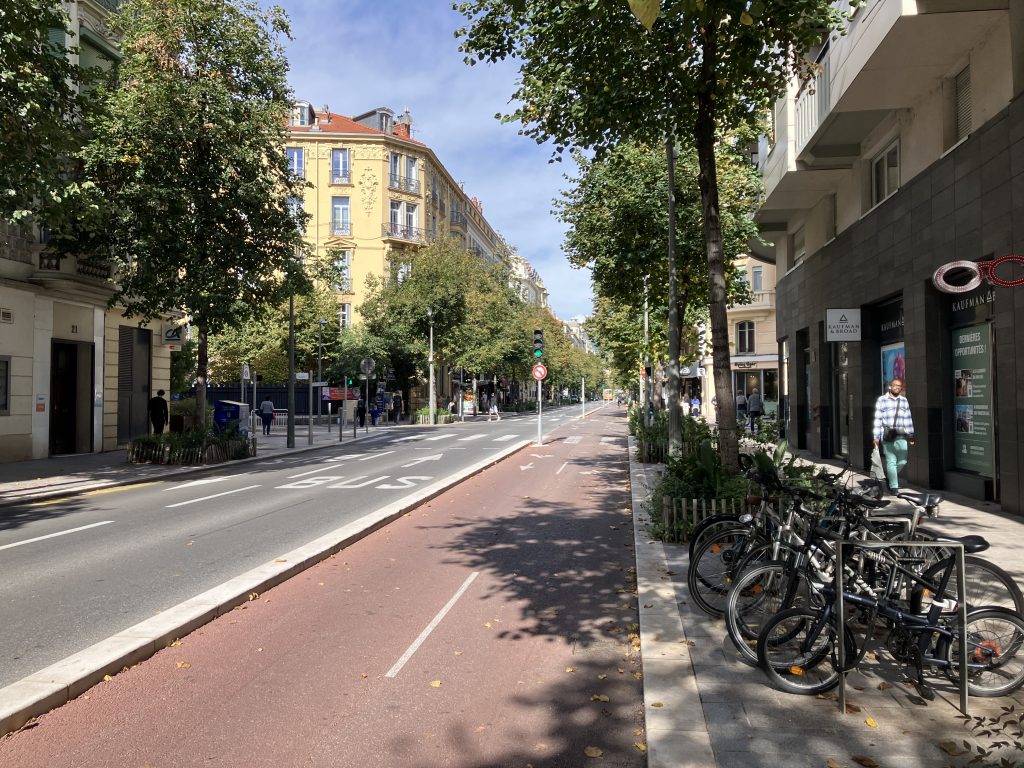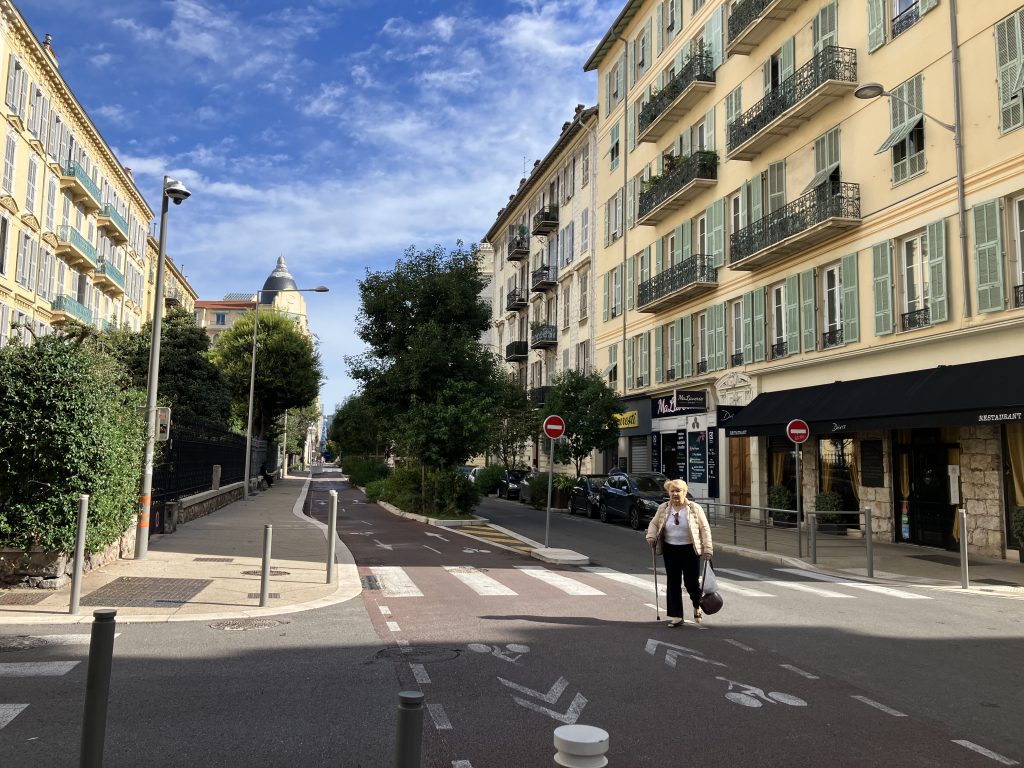Public transport in Nice
In a previous blog I kept during my long association with Nice, just about everything I wrote about public transport is now wrong. So much investment has gone into green transport in the past twenty years that this aspect of the town is has changed beyond all recognition.
Trams prioritised over cars
When we made our very first visit to Nice since my childhood, a chance conversation on a TGV alerted us to the first phase of the change. A couple visiting their daughter in Nice extolled the new tram line that had replaced the traffic jams on Rue Jean Médecin, the main shopping throroughfare. The town mayor, Christian Estrosi, was following a vision for dealing with traffic that involved closing roads to cars.
This was and still is revolutionary. The standard response to traffic jams has been to build or widen roads and create by-passes. But research has shown that building extra road space provides only temporary relief. Fast, convenient roads attract more cars and eventually result, unfortunately, in more traffic jams. To solve traffic problems by closing roads is the unusual response of some forward-thinking planners.
Green lung
While the tram was being built, another large chunk of town-centre road and carpark was being demolished to make way for a park. Yes, a park: trees, lawns, shady walks and fountains. The “Coulée verte” now forms a green lung through the city centre, from the seafront garden Jardin Albert 1er, and still expanding to the north.
These transformations were already underway at the time of our first family visit in 2008. But they were to go much, much further. At the time, our flat near the Boulevard Gambetta was connected to the town centre by a fleet of buses that ran fast on dedicated lanes. But as soon as those buses turned north into Boulevard Gambetta which lacked a bus lane, they became snarled up with lorries, cars, bikes and more buses jostling amid the traffic fumes.
And now?
A second tram line runs through our area, replacing all the buses into town, and connecting us directly with the airport to the west and the sea port to the east. The two roads that once carried buses to and from the centre have been entirely dug up. The bus lanes have been replaced by cycle lanes and long beds of bushes and trees, separating cycles from the single lane for cars.

The Boulevard Gambetta (above), once one of the most traffic-choked, fume-infested arteries, is entirely closed to cars between the railway line and the Promenade, admitting only buses, taxis and bikes. The pavements are lined with trees surrounded by large beds of low bushes and plants, creating a pleasant leafy avenue. A radical change indeed!
Transformational
It’s difficult to overstate the difference all this has made to the feel of the area. Gone are the stress, noise and fumes; cycling into town is now an easy ride of some ten minutes along a safe and pleasant route. During a visit one May, I could hear birdsong and even smell the sea from the street outside our building. A neighbour reported hearing cicadas.
Nor should one underestimate the investment needed to overturn a century of dominance by the private car. Planners have thrown out layers of concrete to install vegetation, created a bicycle infrastructure where there was none, and placed public transport front and centre of their policy. And of course they are not popular with residents who love their cars.
Not many towns that have had the courage to do this; I know of none in the UK. With the recent experience of Low Traffic Neighbourhoods, I can well imagine the backlash.
Challenges
It is fair to say that this rapid transformation has at times been painful for locals. They have had to live with months of noise and dust while new infrastructure was built, and adapt to constant changes that saw cars banned and road directions reversed. Buses were re-routed, re-numbered or simply axed as the trams replaced them. For regular visitors like us, it’s been complicated to keep up with.
And the tram line that has replaced our east-west bus routes, Line 2, is far from perfect. The nearest stop to our flat is a ten-minute walk away, at a point where the line runs deep underground. Instead of walking a couple of minutes to a bus stop and hopping on, we have to schlep further to a tram station and take three long escalator rides down to the actual tram.
The saddest thing about this tram line is that while it crosses the north-south Line 1, there is no proper interchange between the two trams. This is all the more surprising given that that the planners had a blank slate to build as they wanted. The consequence for us is that we have no direct link to the main railway station either by bus or by tram.
Still, there is scope for this situation to be remedied in future, as the bus provision is being continually updated. Nice’s root-and-branch transformation is still ongoing with more parks set to replace concrete squares and more bus routes to be launched.
More, please
It is clear that Estrosi wants to safeguard Nice for the future, and good for him. The city of my childhood memories, with its traffic jams, fumes and angry drivers, is a thing of the past. Whatever the shortcomings Nice has gone from fast and furious to pleasant and liveable, in less than twenty years.
Could these ideas be exported elsewhere? Our home town of Ashford (Kent, UK) is ringed almost entirely by dual carriageways, a concrete jungle that creates pollution for residents and leaves no room for walkers and cyclists. So what is Ashford planning? More dual carriageway.
Nice is prioritising the well-being of its population as climate change begins to bite. Paris is following suit by greening it streets and rooftops, by reducing vehicle traffic in favour of bikes and trams, and even by encouraging swimming in the Seine. I’d like to see that happen in the Thames!
These towns do not claim to be solving global problems; they are simply looking for ways to adapt their dense urban spaces. Paris, already oven-like every year in August, is planning ahead for temperatures of 50 degrees Celsius.
Any investment in transport, anywhere, should happen along exactly these lines.
